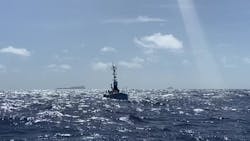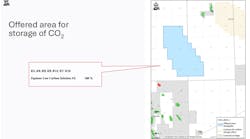Uncrewed surface vessel returns from first volcano caldera survey in South Pacific
Offshore staff
Hunga Tonga–Hunga Ha’apai is a submarine volcano in the South Pacific located about 30 km (19 mi) south of the submarine volcano of Fonuafo’ou and 65 km (40 mi) north of Tongatapu, Tonga’s main island. It is part of the highly active Kermadec-Tonga subduction zone and its associated volcanic arc, which extends from New Zealand north-northeast to Fiji.
For the ongoing second phase of the NIWA/Nippon Foundation Tonga Eruption Seabed Mapping Project–TESMaP, funded by The Nippon Foundation, the USV Maxlimer has been equipped with a multibeam echo sounder to acoustically measure depth and state of the seabed. Importantly, the vessel also has new winch capability for deployment of multiple sensors down to 300 meters, to obtain direct water column measurements.
Data collected using a conductivity temp depth instrument, deployed using the winch, is providing important temperature and salinity information as well as dissolved oxygen and turbidity readings. A miniature autonomous plume recorder, designed to detect chemicals in the water that are common in hydrothermal plumes, is recording light-backscattering for suspended particle concentrations, oxidation reduction potential, temperature and pressure from multiple winch dips and tows. The MAPR project is a joint initiative between NOAA in the USA and GNS Science in New Zealand.
On this survey mission, clear signs of continuing volcanic activity were seen inside the crater, with high particle concentrations in the water that are consistent with earlier observations of ash in the water column. The water in the caldera was also found to be homogenous between 150 and 300 meters depth, suggesting strong mixing inside the caldera. The previously observed oxygen minimum was not as distinct.
Maxlimer will be returning to the caldera for a more detailed survey to fill gaps and better target volcanic plumes and hydrothermal vents with the CTD and MAPR.
The 12-meter USV is being remotely controlled on its caldera missions from SEA-KIT’s base in Essex, UK, where a team of four operators work shifts for round-the-clock operation. A global team of surveyors and scientists based in Australia, Egypt, Ireland, Mauritius, New Zealand, Poland and the USA are collaboratively monitoring and reviewing the data collected.
08.04.2022




